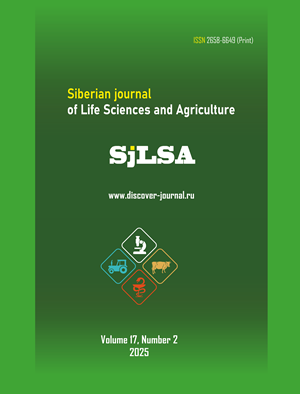Влияние разных способов обработки на фитохимический состав листьев и шишек хмеля обыкновенного (Humulus lupulus L.)
Аннотация
Обоснование. Уже с давних времен установлено, что в лекарственных растениях содержится большое количество активных соединений, которые используются для лечения многих заболеваний. Впервые проведено сравнительное изучение листьев и шишки хмеля обыкновенного по накоплению фитохимических веществ . Были подобраны коммерческие препараты биостимуляторов роста (гибберсиб, эпин-экстра) и био-удобрение (пудрет). Установлено, что хмель, выращенная в условиях Татарстана, обладает богатым фитохимическим составом и большим содержанием биоактивных веществ. Может быть рекомендована в качестве ресурса, что позволит фармакологическую промышленность наиболее качественным сырьем.
Цель исследования. Осуществить сравнительный анализ фитохимических составов листьев и шишек хмеля обыкновенного (Humulus lupulus L.) при различных методах их обработоки.
Материалы и методы исследований. В мае 2023 года в лабораторных условиях была произведена посадка корневищных черенков хмеля в закрытом грунте. В соответствии со схемой эксперимента по первому варианту корневищные черенки были посажены в горшки с почвой, в которой содержался пудрет (био-удобрение из высушенного в СВЧ-лучах птичьего помета, состоит из 88.4% органического вещества, 4.59% азота, 1.80% калия, 3.70% фосфора) в количестве 10 г на 1 кг почвы. По второму способу корневищные черенки хмеля были обработаны гибберсибом (666,6 мкг/л) посредством опрыскивания, по третьему способу они были обработаны эпин-экстра (500 мкл/л) аналогично посредством опрыскивания.
Через 4 недели образцы, обработанные по всем вариантам, и контрольный образец были пересажены в открытый грунт. (кислотность почвы составляла 6.9, концентрация органического вещества (гумуса) – 1,96%, нитратного азота – 35,5 мг/кг, аммиачного азота – 11,3 мг/кг, подвижного фосфора – 584 мг/кг, обменного кальция – 13,25 ммоль/100 г, обменного магния – 1,5 ммоль/100 г).
Пробы для анализа (листья и шишки) были извлечены спустя 12 недель с момента их посадки в открытом грунте (средняя ночная температура составила +140С).
Фитохимический состав в листьях и в шишках определяли спектрофотометрическими методами описано в исследовании Аль Хуссейн и соавторы (2023).
Опыты проводили в шести биологических повторностях. Статистическую обработку данных осуществлялась с использованием программы Excel 2016. Достоверность различия определялась по критерию Манна-Уитни с р ≤ 0,05.
Результаты. Эпин-экстра увеличивал преимущественно концентрацию флавоноидов, дубильных веществ и витамина B2 в образцах, гибберсиб увеличивал концентрацию фенольных соединений, каротиноидов, сахаров и белков, пудрет увеличивал концентрацию витамина С, каротиноидов, витамина B2 и белков.
Заключение. В наших исследованиях можем сделать вывод, что экстракты хмеля имеют более широкий потенциал для использования в области медицины и пищевых технологий, чем просто ферментация, а это связано с возможностью улучшения содержание полезных первичных и вторичных веществ с использованием синтетических регуляторов роста и био-удобрение. Большое количество листьев хмеля остается неиспользованным побочным сельскохозяйственным продуктом, но по нашими исследованиями доказали возможность использования листьев хмеля в качестве источника первичных и вторичных метаболитов в медицине (в качестве седативного, антимикробного, мочегонного, противовоспалительного средства при лечении гастритов, циститов, уретритов, заболеваниях почек, печени и желчного пузыря) и пищевой промышленности (пивоваренной промышленностях, в пекарном производстве).
EDN: ZXTFKS
Скачивания
Литература
Алмуграби, Е. (2021). Фитохимический состав и антиоксидантный статус Brassica oleraceae L. при действии природных и синтетических регуляторов роста растений: Дис. … к-та биол. наук. Казань, 170 с.
Киреева, Т. Б. & Китова, Е. А. (2006). Экологически онтогенетические особенности накопления дубильных веществ в траве душицы обыкновенной в условиях Удмуртии. Биология, (10), 85-96.
Маланкина, Е. Л. Лекарственное применение хмеля. https://www.greeninfo.ru/lianes/humulus_lupulus.html/Article/_/aID/5359
Сажина, Н. Н. & Мисин, В. М. (2011). Измерение суммарного содержания фенольных соединений в различных частях лекарственных растений. Химия растительного сырья, (3), 149-152. EDN: https://elibrary.ru/OHSURD
Шафикова, С. Ф. (2013). Фармакогностическое изучение листьев хмеля обыкновенного (Humulus lupulus L.): Дис. … к-та фарм. наук. Самара, 181 с. EDN: https://elibrary.ru/YGMBGB
Astray, G. & Gullón, P. & Gullón, B. & Munekata, P. E. & Lorenzo, J. M. (2020). Humulus lupulus L. as a natural source of functional biomolecules. Appl. Sci., 10, 5074. https://doi.org/10.3390/app10155074 EDN: https://elibrary.ru/HVXHXH
Colville, L. & Smirnoff, N. (2008). Antioxidant status, peroxidase activity, and PR protein transcript levels in ascorbate-deficient Arabidopsis thaliana vtc mutants. Journal of Experimental Botany, 59(14), 3857-3868. https://www.jstor.org/stable/24037641
Carbone, K. & Gervasi, F. (2022). An Updated Review of the Genus Humulus: A Valuable Source of Bioactive Compounds for Health and Disease Prevention. Plants, (11), 3434. https://doi.org/10.3390/plants11243434 EDN: https://elibrary.ru/UHHOVD
Dedei, A. J. (2021). Assessment of mineral nutrient impact on metabolites accumulation in kale (Brassica oleracea var. sabellica). Siberian Journal of Life Sciences and Agriculture, 13(3), 208-224. https://doi.org/10.12731/2658-6649-2021-13-3-208-224 EDN: https://elibrary.ru/GFXXKY
Faivre, C. & Ghedira, K. & Goetz, P. et al. (2007). Humulus lupulus L. Phytothérapie, 5(2), 86-89. https://doi.org/10.1007/s10298-007-0217-7
Farag, M. A. & Porzel, A. & Schmidt, J. et al. (2011). Metabolite profiling and fingerprinting of commercial cultivars of Humulus lupulus L. (hop): a comparison of MS and NMR methods in metabolomics. Metabolomics, 8(3), 492-507. https://doi.org/10.1007/s11306-011-0335-y EDN: https://elibrary.ru/IDBQZY
Finkelstein, R. R. & Gampala, S. S. L. & Rock, C. (2002). Abscisic Acid Signalling in Seeds and Seedlings. The Plant Cell, 18, 15-45. https://doi.org/10.1105/tpc.010441
Gao, H. & Zhang, Z. & Lv, X. & Cheng, N. & Peng, B. & Cao, W. (2016). Effect of 24-epibrassinolide on chilling injury of peach fruit in relation to phenolic and proline metabolisms. Postharvest Biology and Technology, 111, 390-397.
Kopsell, D. A. & Lefsrud, M. G. & Kopsell, D. E. & Curran Celentano, J. (2005). Air temperature affects biomass and carotenoid pigment accumulation in kale and spinach grown in a controlled environment. Hortscience, 40(7), 2026-2030. https://doi.org/10.21273/HORTSCI.40.7.2026 EDN: https://elibrary.ru/MFRVSL
Bocquet, L. & Sahpaz, S. & Hilbert, J. L. & Rambaud, C. (2018). Humulus lupulus L., a very popular beer ingredient and medicinal plant: overview of its phytochemistry, its bioactivity, and its biotechnology. Phytochem Rev, (17), 1047-1090. https://doi.org/10.1007/s11101-018-9584-y EDN: https://elibrary.ru/KKXZIB
Lyu, J. I. & Ryu, J. & Seo, K. S. & Kang, K. Y. & Park, S. H. & Ha, T. H. & Ahn, J. W. & Kang, S. Y. (2022). Comparative Study on Phenolic Compounds and Antioxidant Activities of Hop (Humulus lupulus L.) Strobile Extracts. Plants, (11), 135. https://doi.org/10.3390/plants11010135 EDN: https://elibrary.ru/CWQHXA
Maša, K. & Eva, Š. & Iztok, J. K. & Željko, K. & Urban, B. (2019). Hop Compounds: Extraction Techniques, Chemical Analyses, Antioxidative, Antimicrobial, and Anticarcinogenic Effects. Nutrients, (11), 257. https://doi.org/10.3390/nu11020257
Muzykiewicz, A. & Nowak, A. & Zielonka-Brzezicka, J. & Florkowska, K. & Duchnik, W. & Klimowicz, A. (2019). Comparison of antioxidant activity of extracts of hop leaves harvested in different years. Herba Pol, 65, 1-9. https://doi.org/10.2478/hepo-2019-0013
Mozafar, A. (2008). Nitrogen fertilizers and the amount of vitamins in plants. Plant Nutrition, 16(12), 2479-2506. https://doi.org/10.1080/01904169309364698
Nionelli, L. & Pontonio, E. & Gobbetti, M. & Rizzello, C. G. (2018). Use of hop extract as antifungal ingredient for bread making and selection of autochthonous resistant starters for sourdough fermentation. Int. J. Food Microbiol, 266, 173-172. https://doi.org/10.1016/j.ijfoodmicro.2017.12.002
Okafor, V. N. & Anyalebechi, R. I. & Okafor, U. W. & Okonkwo, C. P. & Obiefuna, J. N. et al. (2020). Phytochemical Constituents of Extracts of Hops and Some Potential Nigerian Hop Substitutes: A Comparative Study in Beer Brewing. Int J Biol Chem Res, 11(1), 1-7. https://www.researchgate.net/publication/350005833
Al Hussein, D. & Almugrabi, E. & Mostyakova, A. & Timofeeva, A. (2023). Phytochemical composition of Humulus Lupulus L. in ontogeny under different treatments. E3S Web of Conferences, 381, 01022. https://doi.org/10.1051/e3sconf/202338101022 EDN: https://elibrary.ru/KDHRXU
Quifer-Rada, P. & Vallverdú-Queralt, A. & Martínez-Huélamo, M. & Chiva-Blanch, G. & Jáuregui, O. & Estruch, R. & Lamuela-Raventós, R. (2015). A comprehensive characterisation of beer polyphenols by high resolution mass spectrometry (LC-ESI-LTQ-Orbitrap-MS). Food Chem, 169, 336-343. https://doi.org/10.1016/j.foodchem.2014.07.154
Rodolfi, M. & Barbanti, L. & Giordano, C. & Rinaldi, M. & Fabbri, A. & Pretti, L. & Casolari, R. & Beghé, D. & Petruccelli, R. & Ganino, T. (2021). The Effect of Different Organic Foliar Fertilization on Physiological and Chemical Characters in Hop (Humulus lupulus L., cv Cascade) Leaves and Cones. Appl. Sci., (11), 6778. https://doi.org/10.3390/app11156778 EDN: https://elibrary.ru/NIVHWI
Stanius, Ž. & Dūdenas, M. & Kaškonienė, V. & Stankevičius, M. M. & Skrzydlewska, E. & Drevinskas, T. & Ragažinskienė, O. & Obelevičius, K. & Maruška, A. (2022). Analysis of the Leaves and Cones of Lithuanian Hops (Humulus lupulus L.) Varieties by Chromatographic and Spectrophotometric Methods. Molecules, 27, 2705. https://doi.org/10.3390/molecules27092705 EDN: https://elibrary.ru/CMGBSD
Schmidt, S. & Zietz, M. & Schreiner, M. & Rohn, S. & Kroh, L. & Krumbein, A. (2010). Genotypic and climatic influences on the concentration and composition of flavonoids in Kale (Brassica oleracea var. sabellica). Food Chemistry, 119, 1293-1299. https://doi.org/10.1021/jf9033909 EDN: https://elibrary.ru/NAZVGT
Wei, S. & Sun, T. & Du, J. & Zhang, B. & Xiang, D. & Li, W. (2018). Xanthohumol, a prenylated flavonoid from Hops, exerts anticancer effects against gastric cancer in vitro. Oncol. Rep., 40, 3213-3222. https://doi.org/10.3892/or.2018.6723
Shui, Y. C. & Feng, X. & Yan, W. (2009). Advances in the study of flavonoids in Gingko biloba leaves. Medicinal Plant Research, 3, 1248-1252. http://www.academicjournals.org/JMPR
Scheible, W. & Morcuende, R. & Czechowski, T. & Fritz, C. & Osuna, D. & Palacios-Rojas, N. & Schindelasch, D. & Thimm, O. & Udvardi, M. K. & Stitt, M. (2004). Genome-Wide Reprogramming of Primary and Secondary Metabolism, Protein Synthesis, Cellular growth processes, and the regulatory infrastructure of Arabidopsis in response to nitrogen. Plant Physiology, 136, 2483-2499. https://doi.org/10.1104/pp.104.047019
Taylor, A. W. & Barofsky, E. & Kennedy, J. A. & Deinzer, M. L. (2003). Hop (Humulus lupulus L.) proanthocyanidins characterized by mass spectrometry, acid catalysis, and gel permeation chromatography. J. Agric Food Chem, 51, 4101-4110. https://doi.org/10.1021/jf0340409
Tanaka, Y. & Yanagida, A. & Komeya, S. et al. (2014). Comprehensive separation and structural analyses of polyphenols and related compounds from bracts of hops (Humulus lupulus L.). J Agric Food Chem, 62(10), 2198-2206. https://doi.org/10.1021/jf405544n EDN: https://elibrary.ru/SSVWBJ
Treutter, D. (2010). Managing Phenol Contents in Crop Plants by Phytochemical Farming and Breeding-Visions and Constraints. International Journal of Molecular Sciences, (11), 807-857. https://doi.org/10.3390/ijms11030807 EDN: https://elibrary.ru/MZMCTJ
Abrama, V. & Cehb, B. & Vidmara, M. & Hercezia, M. & Lazića, N. & Bucika, V. & Možinaa, S. S. & Koširb, I. J. & Lea Demšara, M. K. & Ulriha, N. P. (2015). A comparison of antioxidant and antimicrobial activity between hop leaves and hop cones. Industrial Crops and Products, 64, 124-134.
Wang, M. & Zheng, Q. & Shen, Q. & Guo, S. (2013). The critical role of potassium in plant stress response. International Journal of Molecular Sciences, 14(4), 7370-7390. https://doi.org/10.3390/ijms14047370
Zanoli, P. & Zavatti, M. (2008). Pharmacognostic and pharmacological profile of Humulus lupulus L. J. Ethnopharmacol., 116, 383-396. https://doi.org/10.1016/j.jep.2008.01.011 EDN: https://elibrary.ru/PRUNSW
References
Almugraby, E. (2021). Phytochemical composition and antioxidant status of Brassica oleraceae L. under the action of natural and synthetic plant growth regulators (Doctoral dissertation). Kazan, 170 p.
Kireeva, T. B., & Kitova, E. A. (2006). Ecological ontogenetic features of tannin accumulation in the grass of common oregano under the conditions of Udmurtia. Biology, (10), 85-96.
Malankina, E. L. Medicinal use of hops. Retrieved from https://www.greeninfo.ru/lianes/humulus_lupulus.html/Article/_/aID/5359
Sazhina, N. N., & Misin, V. M. (2011). Measurement of total phenolic compounds content in different parts of medicinal plants. Chemistry of Plant Raw Materials, (3), 149-152. EDN: https://elibrary.ru/OHSURD
Shafikova, S. F. (2013). Pharmacognostic study of common hop leaves (Humulus lupulus L.) (Doctoral dissertation). Samara, 181 p. EDN: https://elibrary.ru/YGMBGB
Astray, G. & Gullón, P. & Gullón, B. & Munekata, P. E. & Lorenzo, J. M. (2020). Humulus lupulus L. as a natural source of functional biomolecules. Appl. Sci., 10, 5074. https://doi.org/10.3390/app10155074 EDN: https://elibrary.ru/HVXHXH
Colville, L. & Smirnoff, N. (2008). Antioxidant status, peroxidase activity, and PR protein transcript levels in ascorbate-deficient Arabidopsis thaliana vtc mutants. Journal of Experimental Botany, 59(14), 3857-3868. https://www.jstor.org/stable/24037641
Carbone, K. & Gervasi, F. (2022). An Updated Review of the Genus Humulus: A Valuable Source of Bioactive Compounds for Health and Disease Prevention. Plants, (11), 3434. https://doi.org/10.3390/plants11243434 EDN: https://elibrary.ru/UHHOVD
Dedei, A. J. (2021). Assessment of mineral nutrient impact on metabolites accumulation in kale (Brassica oleracea var. sabellica). Siberian Journal of Life Sciences and Agriculture, 13(3), 208-224. https://doi.org/10.12731/2658-6649-2021-13-3-208-224 EDN: https://elibrary.ru/GFXXKY
Faivre, C. & Ghedira, K. & Goetz, P. et al. (2007). Humulus lupulus L. Phytothérapie, 5(2), 86-89. https://doi.org/10.1007/s10298-007-0217-7
Farag, M. A. & Porzel, A. & Schmidt, J. et al. (2011). Metabolite profiling and fingerprinting of commercial cultivars of Humulus lupulus L. (hop): a comparison of MS and NMR methods in metabolomics. Metabolomics, 8(3), 492-507. https://doi.org/10.1007/s11306-011-0335-y EDN: https://elibrary.ru/IDBQZY
Finkelstein, R. R. & Gampala, S. S. L. & Rock, C. (2002). Abscisic Acid Signalling in Seeds and Seedlings. The Plant Cell, 18, 15-45. https://doi.org/10.1105/tpc.010441
Gao, H. & Zhang, Z. & Lv, X. & Cheng, N. & Peng, B. & Cao, W. (2016). Effect of 24-epibrassinolide on chilling injury of peach fruit in relation to phenolic and proline metabolisms. Postharvest Biology and Technology, 111, 390-397.
Kopsell, D. A. & Lefsrud, M. G. & Kopsell, D. E. & Curran Celentano, J. (2005). Air temperature affects biomass and carotenoid pigment accumulation in kale and spinach grown in a controlled environment. Hortscience, 40(7), 2026-2030. https://doi.org/10.21273/HORTSCI.40.7.2026 EDN: https://elibrary.ru/MFRVSL
Bocquet, L. & Sahpaz, S. & Hilbert, J. L. & Rambaud, C. (2018). Humulus lupulus L., a very popular beer ingredient and medicinal plant: overview of its phytochemistry, its bioactivity, and its biotechnology. Phytochem Rev, (17), 1047-1090. https://doi.org/10.1007/s11101-018-9584-y EDN: https://elibrary.ru/KKXZIB
Lyu, J. I. & Ryu, J. & Seo, K. S. & Kang, K. Y. & Park, S. H. & Ha, T. H. & Ahn, J. W. & Kang, S. Y. (2022). Comparative Study on Phenolic Compounds and Antioxidant Activities of Hop (Humulus lupulus L.) Strobile Extracts. Plants, (11), 135. https://doi.org/10.3390/plants11010135 EDN: https://elibrary.ru/CWQHXA
Maša, K. & Eva, Š. & Iztok, J. K. & Željko, K. & Urban, B. (2019). Hop Compounds: Extraction Techniques, Chemical Analyses, Antioxidative, Antimicrobial, and Anticarcinogenic Effects. Nutrients, (11), 257. https://doi.org/10.3390/nu11020257
Muzykiewicz, A. & Nowak, A. & Zielonka-Brzezicka, J. & Florkowska, K. & Duchnik, W. & Klimowicz, A. (2019). Comparison of antioxidant activity of extracts of hop leaves harvested in different years. Herba Pol, 65, 1-9. https://doi.org/10.2478/hepo-2019-0013
Mozafar, A. (2008). Nitrogen fertilizers and the amount of vitamins in plants. Plant Nutrition, 16(12), 2479-2506. https://doi.org/10.1080/01904169309364698
Nionelli, L. & Pontonio, E. & Gobbetti, M. & Rizzello, C. G. (2018). Use of hop extract as antifungal ingredient for bread making and selection of autochthonous resistant starters for sourdough fermentation. Int. J. Food Microbiol, 266, 173-172. https://doi.org/10.1016/j.ijfoodmicro.2017.12.002
Okafor, V. N. & Anyalebechi, R. I. & Okafor, U. W. & Okonkwo, C. P. & Obiefuna, J. N. et al. (2020). Phytochemical Constituents of Extracts of Hops and Some Potential Nigerian Hop Substitutes: A Comparative Study in Beer Brewing. Int J Biol Chem Res, 11(1), 1-7. https://www.researchgate.net/publication/350005833
Al Hussein, D. & Almugrabi, E. & Mostyakova, A. & Timofeeva, A. (2023). Phytochemical composition of Humulus Lupulus L. in ontogeny under different treatments. E3S Web of Conferences, 381, 01022. https://doi.org/10.1051/e3sconf/202338101022 EDN: https://elibrary.ru/KDHRXU
Quifer-Rada, P. & Vallverdú-Queralt, A. & Martínez-Huélamo, M. & Chiva-Blanch, G. & Jáuregui, O. & Estruch, R. & Lamuela-Raventós, R. (2015). A comprehensive characterisation of beer polyphenols by high resolution mass spectrometry (LC-ESI-LTQ-Orbitrap-MS). Food Chem, 169, 336-343. https://doi.org/10.1016/j.foodchem.2014.07.154
Rodolfi, M. & Barbanti, L. & Giordano, C. & Rinaldi, M. & Fabbri, A. & Pretti, L. & Casolari, R. & Beghé, D. & Petruccelli, R. & Ganino, T. (2021). The Effect of Different Organic Foliar Fertilization on Physiological and Chemical Characters in Hop (Humulus lupulus L., cv Cascade) Leaves and Cones. Appl. Sci., (11), 6778. https://doi.org/10.3390/app11156778 EDN: https://elibrary.ru/NIVHWI
Stanius, Ž. & Dūdenas, M. & Kaškonienė, V. & Stankevičius, M. M. & Skrzydlewska, E. & Drevinskas, T. & Ragažinskienė, O. & Obelevičius, K. & Maruška, A. (2022). Analysis of the Leaves and Cones of Lithuanian Hops (Humulus lupulus L.) Varieties by Chromatographic and Spectrophotometric Methods. Molecules, 27, 2705. https://doi.org/10.3390/molecules27092705 EDN: https://elibrary.ru/CMGBSD
Schmidt, S. & Zietz, M. & Schreiner, M. & Rohn, S. & Kroh, L. & Krumbein, A. (2010). Genotypic and climatic influences on the concentration and composition of flavonoids in Kale (Brassica oleracea var. sabellica). Food Chemistry, 119, 1293-1299. https://doi.org/10.1021/jf9033909 EDN: https://elibrary.ru/NAZVGT
Wei, S. & Sun, T. & Du, J. & Zhang, B. & Xiang, D. & Li, W. (2018). Xanthohumol, a prenylated flavonoid from Hops, exerts anticancer effects against gastric cancer in vitro. Oncol. Rep., 40, 3213-3222. https://doi.org/10.3892/or.2018.6723
Shui, Y. C. & Feng, X. & Yan, W. (2009). Advances in the study of flavonoids in Gingko biloba leaves. Medicinal Plant Research, 3, 1248-1252. http://www.academicjournals.org/JMPR
Scheible, W. & Morcuende, R. & Czechowski, T. & Fritz, C. & Osuna, D. & Palacios-Rojas, N. & Schindelasch, D. & Thimm, O. & Udvardi, M. K. & Stitt, M. (2004). Genome-Wide Reprogramming of Primary and Secondary Metabolism, Protein Synthesis, Cellular growth processes, and the regulatory infrastructure of Arabidopsis in response to nitrogen. Plant Physiology, 136, 2483-2499. https://doi.org/10.1104/pp.104.047019
Taylor, A. W. & Barofsky, E. & Kennedy, J. A. & Deinzer, M. L. (2003). Hop (Humulus lupulus L.) proanthocyanidins characterized by mass spectrometry, acid catalysis, and gel permeation chromatography. J. Agric Food Chem, 51, 4101-4110. https://doi.org/10.1021/jf0340409
Tanaka, Y. & Yanagida, A. & Komeya, S. et al. (2014). Comprehensive separation and structural analyses of polyphenols and related compounds from bracts of hops (Humulus lupulus L.). J Agric Food Chem, 62(10), 2198-2206. https://doi.org/10.1021/jf405544n EDN: https://elibrary.ru/SSVWBJ
Treutter, D. (2010). Managing Phenol Contents in Crop Plants by Phytochemical Farming and Breeding-Visions and Constraints. International Journal of Molecular Sciences, (11), 807-857. https://doi.org/10.3390/ijms11030807 EDN: https://elibrary.ru/MZMCTJ
Abrama, V. & Cehb, B. & Vidmara, M. & Hercezia, M. & Lazića, N. & Bucika, V. & Možinaa, S. S. & Koširb, I. J. & Lea Demšara, M. K. & Ulriha, N. P. (2015). A comparison of antioxidant and antimicrobial activity between hop leaves and hop cones. Industrial Crops and Products, 64, 124-134.
Wang, M. & Zheng, Q. & Shen, Q. & Guo, S. (2013). The critical role of potassium in plant stress response. International Journal of Molecular Sciences, 14(4), 7370-7390. https://doi.org/10.3390/ijms14047370
Zanoli, P. & Zavatti, M. (2008). Pharmacognostic and pharmacological profile of Humulus lupulus L. J. Ethnopharmacol., 116, 383-396. https://doi.org/10.1016/j.jep.2008.01.011 EDN: https://elibrary.ru/PRUNSW
Copyright (c) 2025 Dalal Al Hussein, Esraa Almugrabi, Antonina A. Mostyakova, Olga A. Timofeeva

Это произведение доступно по лицензии Creative Commons «Attribution-NonCommercial-NoDerivatives» («Атрибуция — Некоммерческое использование — Без производных произведений») 4.0 Всемирная.

























































